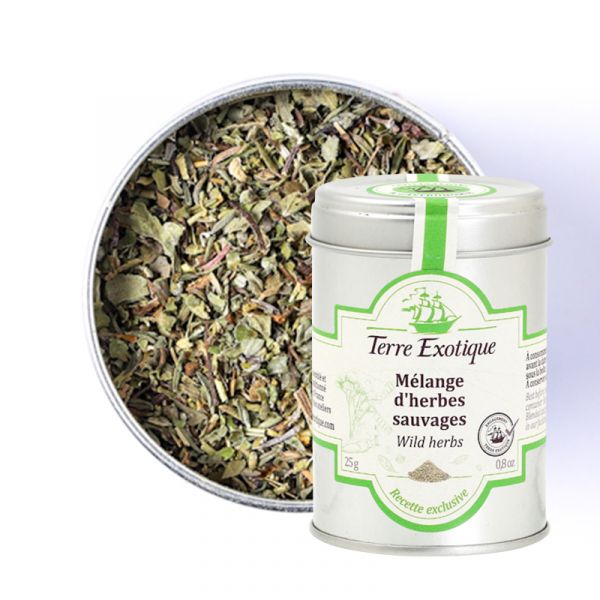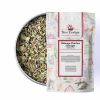



How to Use Wild Herb Blend in Your Cooking?
This blend serves as a aromatic base for many everyday dishes and avoids the addition of sauces and other fats. It flavors all the typical dishes of the Mediterranean region: cooked tomatoes, vegetable tians, stews, and daubes.
Preferably add it at the end of cooking to preserve all the flavors. Do not let it infuse for too long as the aromas of the herbs tend to evaporate.
How to Use Wild Herb Blend in Cooking?
Here are some recipe ideas for using the wild herb blend in your cooking:
- Carrot Hummus with Wild Herbs: Add 1 teaspoon of wild herb blend to your carrots while cooking;
- Chilled Tomato Soup with Wild Herbs: At the end of cooking your tomatoes, sprinkle 2 teaspoons of wild herbs;
- Marinated Herb Skewers: Add 1 tablespoon of wild herbs to your pieces of meat to marinate;
- Sunshine Vegetable Tian: Before baking, sprinkle 1 tablespoon of wild herbs over your vegetables;
- Baked Camembert with Wild Herbs: Sprinkle 1 teaspoon of wild herb blend over your Camembert before baking.
Unmistakable Herbaceous Notes
The wild herb blend has powerful aromas and easily integrates into many dishes. Fresh and balanced, this blend constitutes an aromatic base to enhance all dishes, whether baked, grilled, or pan-fried.
What is the Wild Herb Blend?
The wild herb blend consists of thyme, rosemary, basil, oregano, and marjoram.
Thyme, whose botanical name is Thymus vulgaris, is an emblematic aromatic plant of Mediterranean cuisine. It is a perennial plant of the Lamiaceae family, like oregano or mint. Growing in the south of Europe, this aromatic plant mainly develops under a hot, sunny, and dry climate, which allows it to release pungent and fragrant aromas.
The name of rosemary comes from the Latin "rosmarinus," meaning "dew of the sea." Rosemary is a shrub called Rosmarinus officinalis growing wild throughout the Mediterranean basin. Rosemary from Crete is cultivated on terraces, in accordance with organic farming, on the mountains and hills overlooking the sea. It is then dried in traditional dryers, open to the winds.
Basil, whose botanical name is Ocimum basilicum L., is a herbaceous plant of the Lamiaceae family, like oregano or marjoram. Basil grows in the form of branched stems. It is one of the emblems of Italian cuisine.
Oregano, with its botanical name Origanum vulgare, is a perennial herbaceous plant of the Lamiaceae family, like marjoram, a plant with which it is often confused. Indeed, these two plants are very similar both in terms of botanical characteristics and medicinal or aromatic virtues.
Marjoram, whose botanical name is Origanum majorana, is a perennial plant of the Lamiaceae family, cultivated to serve as a condiment, it closely resembles oregano.
Wild Herbs Through History
Wild plant foraging has been an integral part of our cultures for over 5000 years. Foraging was practiced until the 19th century, when agriculture became important. Even though agriculture was the main source of food for populations, foraging allowed peoples to survive until the next harvest, especially in April until March when winter reserves began to run out.
Wild herbs have always nourished people.
Even today, widely used in 21st-century cuisine, wild herbs have their place in our cupboards and will do so for a long time to come!
| Allergen | Absence |
|---|---|
| Native country | FRANCE |
| Ingredients | rosemary, oregano, thyme, basilic, marjoram. |
| Nutritional Info | VN Energie pour 100 g (energy for 100g) : 893 kJ / 214 kcal VN Matière grasse (fat) : 7.9 g Dont acide gras saturés (of which saturated fat) : 2.8 g VN Glucides (carbohydrate) : 23.5g Dont sucres (of which sugars) : 2.2 g VN Protéines (protein) : 9.5 g Vn Sel (salt) : 0.8 g |
| TRACES EVENTUELLES D'ALLERGÈNES | céleri, sésame, moutarde, fruits à coques. |
 Français
Français 